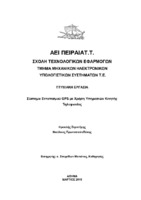| dc.contributor.advisor | Ματιάτος, Σπυρίδων | |
| dc.contributor.author | Πρωτοπαπαδάκης, Νικόλαος | |
| dc.contributor.author | Στρατήγης, Ηρακλής | |
| dc.date.accessioned | 2016-05-27T07:19:55Z | |
| dc.date.available | 2016-05-27T07:19:55Z | |
| dc.date.issued | 2016-03-30 | |
| dc.identifier.uri | http://okeanis.lib2.uniwa.gr/xmlui/handle/123456789/2808 | |
| dc.description.abstract | Στην παρούσα Πτυχιακή Εργασία έγινε η ανάπτυξη μιας φορητής συσκευής εντοπισμού θέσης, με αυτοματοποιημένη διαδικασία αποστολής της θέσης της (γεωγραφικό μήκος και πλάτος), μέσω μηνύματος (sms), από την ίδια την συσκευή προς τον κάτοχό της, κάθε φορά που η συσκευή, αντιλαμβάνεται κάποια κίνηση στον επιβλεπόμενο χώρο. Στο μήνυμα το οποίο αποστέλλεται, συμπεριλαμβάνεται ηλεκτρονικός σύνδεσμος, μέσω της εφαρμογής Google Maps, για πληρέστερη ενημέρωση του ιδιοκτήτη της συσκευής.
Η ανάπτυξη της εφαρμογής στηρίχθηκε στις τεχνολογίες των δικτύων κινητής τηλεφωνίας, σε σύγχρονους αισθητήρες εντοπισμού κίνησης καθώς επίσης και στη χρήση της πλατφόρμας ανοικτού υλικού Arduino που βοήθησε ιδιαίτερα στον συνδυασμό όλων των επιμέρους τμημάτων σε ένα τελικό σύνολο. Στο επίπεδο του λογισμικού έγινε χρήση τεχνολογιών ανοιχτού κώδικα μέσω του προκαθορισμένο λογισμικού που προσφέρεται δωρεάν στο διαδίκτυο για την πλατφόρμα Arduino. Όσον αφορά τον σχεδιασμό της κατασκευής, χρησιμοποιήθηκαν κατά το δυνατόν περισσότερο οικονομικά, μικρά σε μέγεθος και σε βάρος υλικά, ώστε το τελικό αποτέλεσμα να είναι προσιτό από θέμα κόστους αλλά και μεταφοράς. Καθώς η εν λόγω συσκευή προορίζεται να χρησιμοποιηθεί κυρίως για λόγους ασφαλείας, ιδιαίτερη σημασία δόθηκε στη διακριτική της εμφάνιση και στην εύκολη τοποθέτησή της σε μέρη όπου δεν θα γίνεται αντιληπτή. Τέλος, στο πλαίσιο της μελλοντικά πιθανής εμπορικής προώθησης της συσκευής, υλοποιήθηκε ένας ιστότοπος, όπου παρουσιάζει μια γενική περιγραφή της, στοιχεία για τους δημιουργούς της καθώς και μια φόρμα επικοινωνίας. Για την υλοποίηση του συγκεκριμένου ιστότοπου χρησιμοποιήθηκαν σύγχρονες τεχνολογίες ανάπτυξης ιστοσελίδων, όπως η HTML και η CSS. | el |
| dc.format.extent | 138 σελ. | el |
| dc.language.iso | el | el |
| dc.publisher | Α.Ε.Ι. Πειραιά Τ.Τ. | el |
| dc.rights | Αναφορά Δημιουργού-Μη Εμπορική Χρήση-Όχι Παράγωγα Έργα 3.0 Ελλάδα | * |
| dc.rights.uri | http://creativecommons.org/licenses/by-nc-nd/3.0/gr/ | * |
| dc.subject | TPSH::Τεχνολογία | el |
| dc.subject | TPSH::Επιστήμη Υπολογιστών | el |
| dc.title | Σύστημα εντοπισμού GPS με χρήση υπηρεσιών κινητής τηλεφωνίας | el |
| dc.type | Πτυχιακή εργασία | el |
| dc.contributor.committee | Δροσινόπουλος, Παναγιώτης | |
| dc.contributor.committee | Ματιάτος, Σπυρίδων | |
| dc.contributor.committee | Έλληνας, Ιωάννης Δρ. | |
| dc.contributor.department | Τμήμα Μηχανικών Ηλεκτρονικών Υπολογιστικών Συστημάτων Τ.Ε. | el |
| dc.contributor.faculty | Σχολή Τεχνολογικών Εφαρμογών | el |
| dc.subject.keyword | Δίκτυα κινητής τηλεφωνίας | el |
| dc.subject.keyword | Arduino | el |
| dc.subject.keyword | GPS | el |
| dc.subject.keyword | Αισθητήριο ανίχνευσης κίνησης (PIR) | el |
| dc.subject.keyword | GSM | el |
| dc.subject.keyword | HTML | el |
| dc.subject.keyword | CSS | el |
| dc.subject.keyword | Javascript | el |
| dc.subject.keyword | Μικροελεγκτές | el |
| dc.description.abstracttranslated | The purpose of this thesis is the development and promotion of a portable position tracking system, that includes an automated process of sending necessary information (longitude and latitude) which are being generated by the device itself. At the same time, the message that is sent, includes a Google Maps link so that the device owner can have access to direct position updates. This message is sent by the device itself to its owner whenever the device, tracks some movement in the surveyed area.
The development of the application was based on the technologies of mobile networks, modern motion detection sensors as well as on the Arduino open hardware platform. The use of the Arduino platform is foundational for this device as it facilitates the combination of all the individual parts into a final set. As far as the software is concerned, open source technologies were used through the predefined software offered by Arduino for free on the internet. At the design level of the construction, the materials that were used were as economical and light as possible so that the final result could be affordable and easily transportable. The final implementation is compact, which makes the device discreet and easy to install in places where it shouldn’t be perceived. Finally, for the subsequent promotion of the device, a website was implemented which presents a general description of the tracking system, some information about its designers, as well as a contact form. Several modern web development technologies were used for the implementation of this particular website like HTML and CSS. | el |


